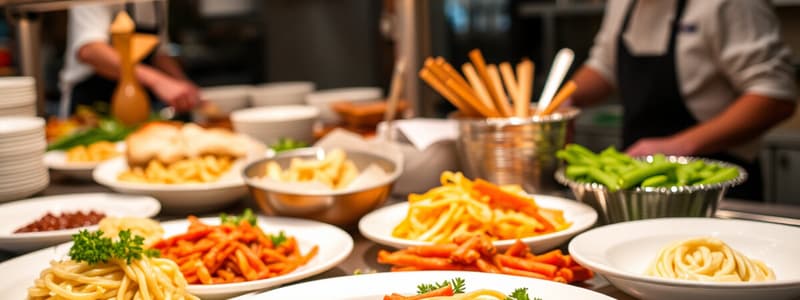Podcast
Questions and Answers
What is one key benefit of using standardized recipes in food preparation?
What is one key benefit of using standardized recipes in food preparation?
- Ensures a consistent quality and quantity (correct)
- Reduces the need for trained staff
- Increases cooking time
- Increases ingredient variability
Which benefit of standardized recipes specifically addresses dietary restrictions?
Which benefit of standardized recipes specifically addresses dietary restrictions?
- Reducing waste
- Standard portion size/cost
- Aiding in forecasting and purchasing
- Assuring nutritional content and addressing dietary concerns (correct)
How do standardized recipes contribute to staff training?
How do standardized recipes contribute to staff training?
- They eliminate the need for training
- They make training more efficient and systematic (correct)
- They focus solely on theory over practice
- They require specialized training for each recipe
What role do standardized recipes play in consumer expectations?
What role do standardized recipes play in consumer expectations?
Which of the following is NOT a benefit of using standardized recipes?
Which of the following is NOT a benefit of using standardized recipes?
What does the term 'Total Yield' refer to in a standardized recipe?
What does the term 'Total Yield' refer to in a standardized recipe?
Which element of a standardized recipe provides specific directions on how to prepare the dish?
Which element of a standardized recipe provides specific directions on how to prepare the dish?
What is typically included in the 'Mise en place' section of a standardized recipe?
What is typically included in the 'Mise en place' section of a standardized recipe?
Which of the following is NOT typically an element of a standardized recipe?
Which of the following is NOT typically an element of a standardized recipe?
What is the purpose of including 'Special instructions' in a standardized recipe?
What is the purpose of including 'Special instructions' in a standardized recipe?
Flashcards are hidden until you start studying
Study Notes
Benefits of Using a Standardized Recipe
- Ensures consistent quality and quantity in food production.
- Establishes standard portion sizes which aid in cost control.
- Addresses nutritional content and dietary considerations, accommodating special diets and allergies.
- Ensures adherence to "Truth in Menu" regulations, promoting transparency.
- Enhances forecasting and purchasing accuracy based on predictable output.
- Incorporates work simplification to streamline processes and supports cross-training initiatives.
- Serves as a training tool for new employees, promoting uniformity in standards.
- Integrates HACCP principles to maintain food safety throughout preparation.
- Helps in minimizing food waste through precise measurements and processes.
- Facilitates meeting customer expectations by delivering consistent results.
Elements of a Standardized Recipe
- Menu item name: Must align with menu descriptions for clarity and consistency.
- Total Yield: Indicates how many portions a recipe produces and may include total weight or volume.
- Portion size: Specifies the quantity of each individual serving.
- Ingredient list/quantity: Defines exact measurements for each ingredient; spices can vary based on personal preference.
- Preparation procedures: Outlines the specific steps and techniques required for recipe execution, such as mixing or sautéing.
- Cooking temperatures and times: Includes critical control points per HACCP to ensure safety and proper cooking.
- Special instructions: Provides operational guidelines in a standardized format relevant to the establishment.
- Mise en place: Compiles a list of essential small equipment and preparation steps for ingredients.
- Service instructions: Details necessary hot and cold storage requirements for optimal food safety and quality.
Studying That Suits You
Use AI to generate personalized quizzes and flashcards to suit your learning preferences.




